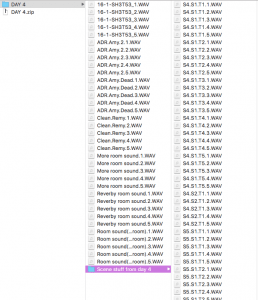After the 4th day we were finished and I thought it would ben beneficial to tie all the days back to my initial aims and objectives as a method of checking what I’ve gained from this process so far.
For this project I would be included in both the on location recording and the postproduction edit. I would however take the lead on the recording side of the project. This meant on set my responsibilities included listening over the takes constantly. I would also be operating the boom whilst constantly monitoring where the best location to shoot from would be.
By offering a location sound service to our clients we tackled one of the three aims of the project. One of the key factors to completing the aim however was to stick to the initial genre of this film which was post apocalyptic. To ensure the recordings fit in with the film brief, I made sure to be constantly wary of external factors when recording such as people passing by and vehicles going past.
Upon finishing recording on location I thought it’d be beneficial to go through my personal project goals and check how this project had helped my develop my skills
“To better familiarize myself with on location recording equipment such as the F8 and 633”
For the shoots we would exclusively be using the 633 on field recording device, as it was the device that Ed and me had both been taught on in the second year of University. As we were not entirely familiar with the device though, we saw it fit to take it out with us on our sound reconnaissance so that we’d fully comfortable when it came to actually recording on set. We soon grasped the basics of the device and could easily get an active signal path straight up. Navigating the menu’s proved to be quite tricky as if offered a very different interface to other sound recording devices (such as the Zoom H4n) but it soon became second nature to us. Although we got to the point where I was quite satisfied with how much I’d learn about the device we were informed after finishing our shoot that the 633 offers the ability to rename files. Retrospectively this would of saved us the few hours it took to rename all the sound files to the relevant scene, slate and take names but it wasn’t that detrimental to the overall process of becoming comfortable using the 633 deceive.
“To improve my skillset when it comes to work with clients”
Throughout this process I would constantly be in contact with both the directors and producer of the film ensuring when and where I’d be wanted. It was important to the overall film that we kept constant contact with the filming group including going to meetings with them. This was due to the fact that it’d give us more of an idea of what they wanted and what they envision for the final product.
“To place a lot of effort on pre-planning, making sure that every stage of production goes off without complaints and overall, to improve my organizational skills.”
To ensure I met this goal I put a lot of emphasize on staying in touch with the team on a regular basis. By going to a lot of the meetings I would constantly be in the know when it came to the overall schedule of the project. Going to each location before filming also offered a chance to speed up the process on set, ensuring that Ed and I would be able to set up and transition between scenes a lot easier without taking away valuable film time. We would also constantly communicate before and after the set, setting out what we needed to record to guarantee a much easier overall editing process.
 (Files from day 4 of recording.)
(Files from day 4 of recording.)